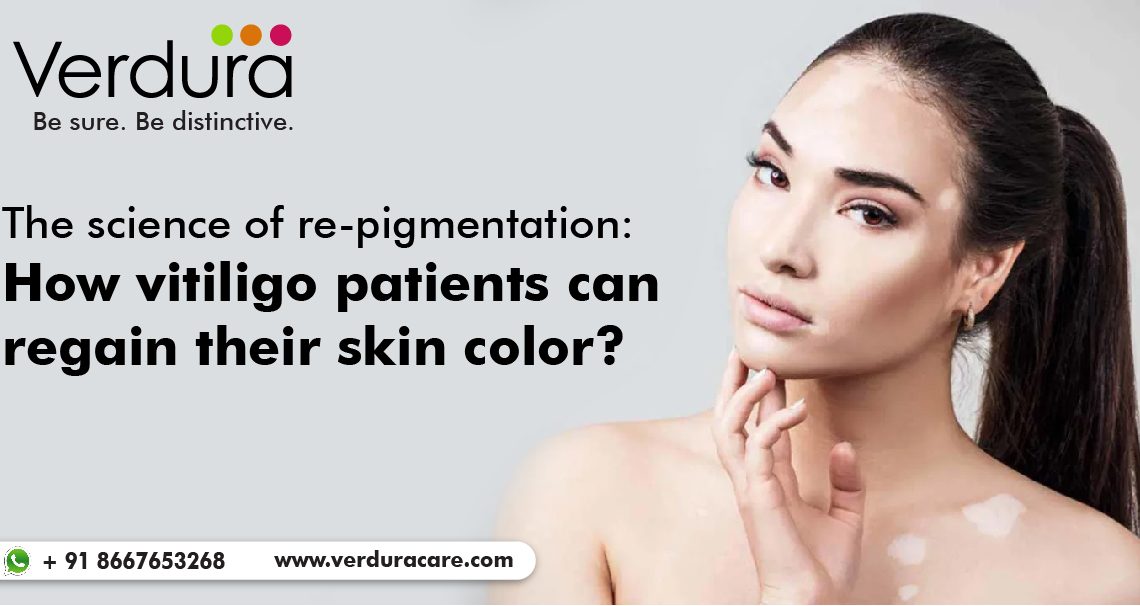The Science of Re-pigmentation: How Vitiligo Patients Can Regain Their Skin Color?

Vitiligo is a chronic skin condition that results in the loss of pigmentation in various parts of the body. The cause of vitiligo is not fully understood, but it is believed to be an autoimmune disorder in which the body’s immune system attacks and destroys the melanocytes (pigment-producing cells) in the skin.
Re-pigmentation is the process of restoring pigment to the skin in areas affected by vitiligo. It can occur spontaneously or with the help of various treatment options. In this blog, we will explore how re-pigmentation happens in vitiligo.
Spontaneous Re-pigmentation
Spontaneous re-pigmentation refers to the natural restoration of pigment in areas affected by vitiligo without any medical intervention. This can happen in some cases, although it is rare. Spontaneous re-pigmentation is more likely to occur in individuals with focal or segmental vitiligo, which affects a limited area of the body.
The exact mechanism of spontaneous re-pigmentation is not fully understood. It is believed to occur due to the migration of melanocytes from adjacent pigmented areas into the depigmented areas. Melanocytes are the cells responsible for producing pigment in the skin. The migration of melanocytes is thought to be triggered by a variety of factors, including UV radiation, trauma to the skin, and inflammation.
Treatment-Induced Re-pigmentation
Treatment options for vitiligo aim to stimulate re-pigmentation in depigmented areas of the skin. Some of the commonly used treatments for re-pigmentation include:
Topical corticosteroids – Topical corticosteroids are a common treatment for vitiligo. They work by reducing inflammation and suppressing the immune response that is responsible for destroying melanocytes. Topical corticosteroids are most effective in treating small areas of depigmentation.
Topical calcineurin inhibitors – Topical calcineurin inhibitors are another type of medication used to treat vitiligo. They work by suppressing the immune response and reducing inflammation in the skin. Topical calcineurin inhibitors are effective in treating areas of depigmentation that are resistant to topical corticosteroids.
Phototherapy – Phototherapy involves exposing the affected skin to ultraviolet light. This can be done using a narrowband UVB lamp or a PUVA lamp, which uses UVA light in combination with a psoralen medication. Phototherapy works by stimulating melanocyte production and reducing inflammation in the skin.
Excimer laser – Excimer laser treatment involves using a laser to deliver targeted UVB light to the affected areas of the skin. This treatment is effective in treating small areas of depigmentation.
Surgical treatment – Surgical treatment for vitiligo involves grafting healthy skin from one area of the body onto the depigmented areas. This can be done using various techniques, including punch grafting, suction blister grafting, and split-thickness skin grafting.
The exact mechanism of re-pigmentation induced by these treatments is not fully understood. It is believed that these treatments work by stimulating the migration and proliferation of melanocytes from adjacent pigmented areas of the skin into the depigmented areas. These treatments may also stimulate the production of melanocyte-stimulating hormones, which can help to increase melanocyte production.
In conclusion, re-pigmentation in vitiligo can occur spontaneously or with the help of various treatment options. Spontaneous re-pigmentation is rare and more likely to occur in individuals with focal or segmental vitiligo. Treatment options for re-pigmentation include topical corticosteroids, topical calcineurin inhibitors, phototherapy, excimer laser, and surgical treatment. These treatments work by stimulating the migration and proliferation of melanocytes into the depigmented areas of skin. Verdura presents two potential products which includes Verdura mela pro the best vitiligo treatment cream & verdura mela gain cream for vitiligo. Verdura mela pro cream can be used as a pre – treatment product for faster re- pigmentation. Apply Verdura mela pro cream and expose to sun light for 5 minutes in morning and wash off. Then apply Verdura mela gain cream on the required areas.